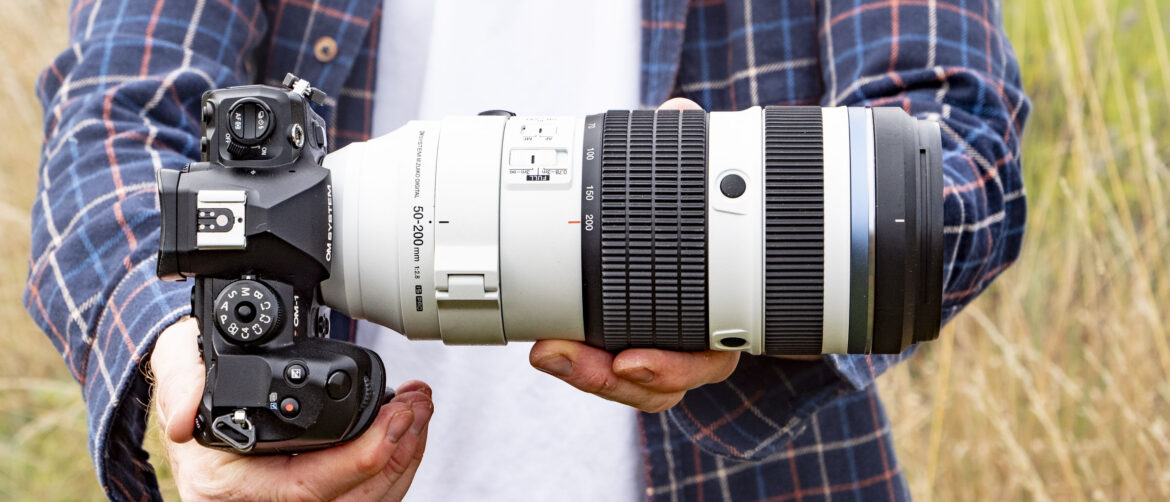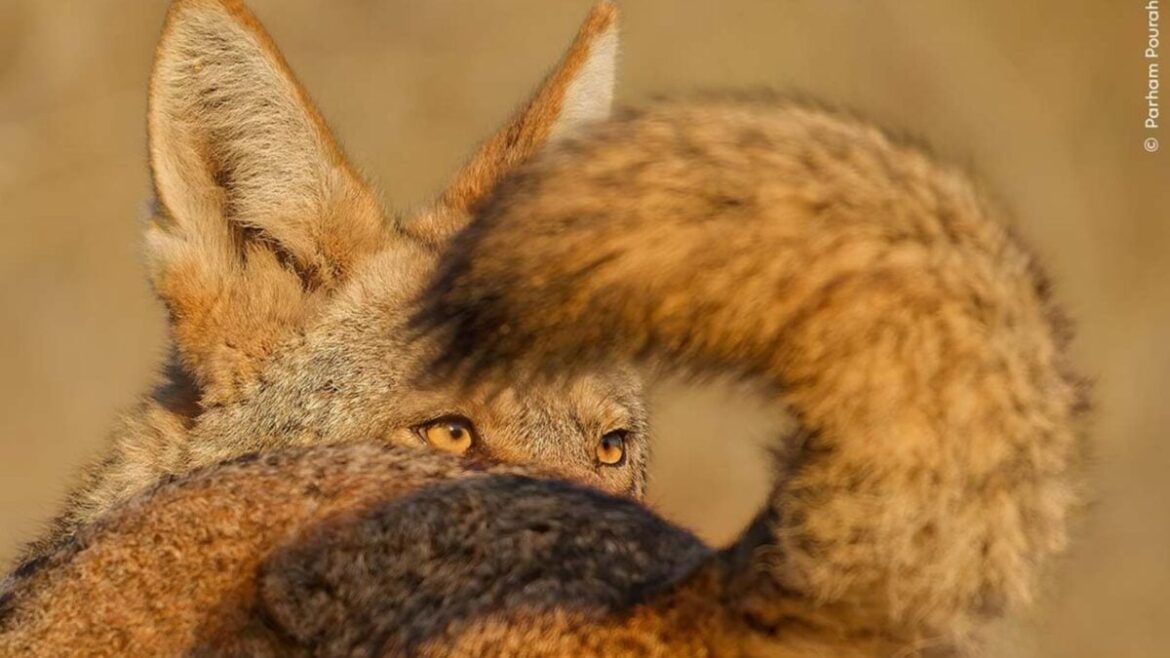Why you can trust TechRadar
We spend hours testing every product or service we review, so you can be sure you’re buying the best. Find out more about how we test.
OM System M.Zuiko Digital ED 50-200mm F2.8 IS Pro: two-minute review
Having shot with the OM System 50-200mm F2.8 zoom, I’m now an even bigger fan of the Micro Four Thirds format for wildlife photography than I was previously. It’s a fabulous lens in every regard, with superb build quality, excellent handling and top-drawer image quality.
Above all, its bright maximum f/2.8 aperture – which is a first for a 100-400mm equivalent lens – delivers super-fast shutter speeds and better light intake than cheaper alternatives, which levels up the kind of telephoto wildlife action it’s possible to capture.
I tested the telephoto zoom with an OM System OM-1 II; together the IP53-rated weather-resistant pairing are impressively lightweight at just 59oz / 1,674g, and deliver incredible image stabilization and subject-detection autofocus performance, especially for birds – the lens’s autofocus can continuously keep up with the camera’s blazing 50fps burst shooting speeds.
I love how the lens balances with the camera, and I happily carried the pairing all day, rain or shine. Its internal zoom further protects against potential dust ingress over the long run, and I’ve no doubt it’ll last for many years of heavy use.
Image 1 of 3
(Image credit: Tim Coleman)(Image credit: Tim Coleman)(Image credit: Tim Coleman)
Detail is impressively sharp, even at f/2.8, which is the aperture I used the most. This setting also enables the use of the fast shutter speeds that are crucial for high-speed wildlife photography.
Bokeh at f/2.8 is smooth for the most part, though in some scenarios it appeared a little fussy. Close the aperture down and you lose the circular shaping, and get harder edges instead. Bokeh is fine overall, but this is probably the only real negative to mention regarding optical quality.
Close focusing impresses – just 0.78m at any focal length, for up to half-life-size macro capture.
I do have to get the small matter of the price out of the way at this point. At £3,000 (US and Australia pricing is TBC), the 50-200mm F2.8 IS Pro is less than half the price of OM System’s other pro ‘white’ lens, the 150-400mm F4.5, but almost three times the price of the 40-150mm F2.8.
In fact, it’s pricier than similar full-frame lenses – Nikon’s 100-400mm f/4.5-5.6 VR S comes to mind. However, considering the features on board, the build and optical quality, and that maximum f2.8 aperture, it’s still decent value, even if many will be priced out.
I can’t fault the OM System 50-200mm F2.8 as an overall package. It’s a superb telephoto zoom, and one that I can only dream will one day live in my gear bag. If you’re a serious wildlife shooter, OM System has produced one of the best camera and lens pairing you can find.
OM System M.Zuiko Digital ED 50-200mm F2.8 IS Pro specs
Swipe to scroll horizontallyOM System M.Zuiko Digital ED 50-200mm F2.8 IS Pro specs
Type:
Telephoto zoom
Mount:
Micro Four Thirds
Sensor:
Micro Four Thirds
Focal length:
50-200mm (100-400mm effective)
Max aperture:
f/2.8
Minimum focus:
0.78m
Filter size:
77mm
Dimensions:
91.4 x 225.8mm
Weight:
38oz / 1,075g (without collar)
OM System M.Zuiko Digital ED 50-200mm F2.8 IS Pro: Design
- IP53-rated weather-resistant design, internal zoom
- Relatively lightweight at 38oz / 1,075g
- 0.78m close focusing for 0.5x (equivalent) magnification
I can’t find any fault in the 50-200mm F2.8’s design. It’s IP53-rated, and is weather-resistant and freeze-proof to -10C; its internal zoom – a feature you’ll generally only find in high-end optics – is further evidence of its rugged credentials, as it’s one less place for potential dust ingress.
Check out the images below, which show how the lens barrel remains unchanged as you zoom through the focal range.
Considering its features – particularly that focal length and maximum aperture combo – it’s lightweight too, at 38oz / 1,075g (without the removable collar). Paired with an OM System camera like the OM-1 II, the total weight is only 59oz / 1,674g, making for a comfortable all-day carry.
Image 1 of 2
(Image credit: Tim Coleman)(Image credit: Tim Coleman)
All the external controls you’d want in a telephoto zoom are here: optical stabilization, manual / autofocus switch, custom buttons, and a focus range limiter.
Focus range can be limited to 0.78-3m, which is handy for macro photography (for which the lens has that impressive minimum close-focusing distance 0.78m), or to 3m to infinity, which is the option I’d pick when shooting telephoto wildlife. A third option is the full focus distance range, which could increase the risk of focus hunting.
The lens is supplied with a tripod collar, and I tend to keep this attached even when shooting handheld, as it provides another point of contact or place to hold when shooting.
Image 1 of 5
(Image credit: Tim Coleman)(Image credit: Tim Coleman)(Image credit: Tim Coleman)(Image credit: Tim Coleman)(Image credit: Tim Coleman)
There’s no built-in teleconverter, which is a feature you’ll sometimes find in high-end telephoto lenses, including OM System’s own monster 150-400mm F4.5. However, I’d happily use OM System’s 1.4x teleconverter with this lens – I’ve used it before, and I wouldn’t expect to see any significant drop off in image quality.
Adding the 1.4x teleconverter extends the maximum reach of the lens at the cost of 1EV of light, effectively turning this into a 560mm f/4 lens. That’s still seriously impressive, and a better reach for bird photography, where subjects tend to be small and tricky to get close to.
OM System M.Zuiko Digital ED 50-200mm F2.8 IS Pro: Performance
- 100-400mm effective focal length with maximum f/2.8 aperture
- Optical and camera stabilization combine for up to 7.5EV stabilization
- Sharp detail and, for the best part, smooth bokeh
- Supports 50fps burst shooting with continuous autofocus
The OM System 50-200mm F2.8 is an impressive performer in every respect. Its autofocus speed and precision are top drawer; when paired with the OM-1 II, it quickly latched onto subjects such as birds, and was able to support 50fps burst shooting with continuous autofocus.
The lens’s optical stabilization can also combine with the OM-1 II’s in-body image stabilization to deliver up to 7.5EV of stabilization.
In real terms, OM System says you can shoot handheld at the maximum focal length, which is 400mm (effective), using shutter speeds as slow as 1/3 sec, and still get sharp results.
Of course, if the action is moving then 1/3 sec won’t be of much use, unless you want to intentionally blur your subject, but static objects will indeed appear sharp based on my testing.
Image 1 of 10
I used the continuous high burst shooting to increase my chances of freezing the action at the right moment in these two scenarios. (Image credit: Tim Coleman)(Image credit: Tim Coleman)(Image credit: Tim Coleman)(Image credit: Tim Coleman)(Image credit: Tim Coleman)(Image credit: Tim Coleman)(Image credit: Tim Coleman)(Image credit: Tim Coleman)(Image credit: Tim Coleman)(Image credit: Tim Coleman)
For me, what’s even better to have than the superb stabilization performance is the bright maximum f/2.8 aperture. This enables fast shutter speeds to freeze action, which is personally what I’m looking for a lens like this to do – for wildlife, you can do so much more with a f/2.8 telephoto than, say, an f/5.6 one.
The 100-400mm effective focal length range easily covers a range of scenarios – it’s my go-to range for grassroots sports like soccer, and for large wildlife. To give you an idea of the difference between 100mm and 400mm, I’ve taken pictures of the same scene at those extremes, and you can see some examples in the gallery below.
Image 1 of 6
400mm(Image credit: Tim Coleman)400mm(Image credit: Tim Coleman)100mm(Image credit: Tim Coleman)400mm(Image credit: Tim Coleman)100mm(Image credit: Tim Coleman)400mm(Image credit: Tim Coleman)
I also explored macro photography with the 50-200mm F2.8, and you can see some of those pictures below. The 0.25x maximum magnification (which is 0.5x full-frame effective) is half-life size and super-versatile – there’s no such full-frame lens with such a feature set.
It was while using the lens to shoot macro, including a dew-covered backlit spider’s web at first light, that I started paying particular attention to the bokeh – the quality of the out-of-focus orbs of light.
At f/2.8 it’s smooth and rounded, but there are scenarios, such as the cobweb shots, where it becomes a little fussy rather than smooth – stopping the aperture down to f/7.1 to increase depth of field revealed polygonal-shaped bokeh. For less extreme scenarios, bokeh quality is pleasant, but I wouldn’t buy this lens solely for that attribute.
Image 1 of 10
I took this photo at f/7.1 to increase depth of field, and you see that the bokeh has hard edges and polygonal shape, produced by the lens’s nine aperture blades. (Image credit: Tim Coleman)(Image credit: Tim Coleman)Here I’ve opened up the aperture and bokeh is rounder, but detail in the spider is softer because of the shallow depth of field. (Image credit: Tim Coleman)(Image credit: Tim Coleman)(Image credit: Tim Coleman)(Image credit: Tim Coleman)(Image credit: Tim Coleman)(Image credit: Tim Coleman)(Image credit: Tim Coleman)(Image credit: Tim Coleman)
Where this lens shines is in its wonderfully sharp detail, no matter the focal length or aperture (f/2.8 to f/11, at least). I’ve been really impressed by the quality of detail in my subjects, and I’ve been able to shoot images that simply wouldn’t be possible with cheaper gear, or even with full-frame lenses with darker maximum apertures, like the Nikon 100-400mm.
If anything is holding this lens back, it’s the limitations of the Micro Four Third’s sensor format, which is half the size of full-frame. It’s less clean in low light, and dynamic range is a little limited in high-contrast scenes, like the sunrise shot in the gallery below (scroll past those adorable guinea pigs).
The maximum f/2.8 aperture mostly makes up for any sensor format limitations, though, and in its own right the OM System 50-200mm F2.8 is a top-quality telephoto zoom, with no real drawbacks.
Image 1 of 10
(Image credit: Tim Coleman)(Image credit: Tim Coleman)(Image credit: Tim Coleman)(Image credit: Tim Coleman)(Image credit: Tim Coleman)(Image credit: Tim Coleman)(Image credit: Tim Coleman)(Image credit: Tim Coleman)(Image credit: Tim Coleman)(Image credit: Tim Coleman)
Should you buy the OM System M.Zuiko Digital ED 50-200mm F2.8 IS Pro?
Buy it if…
Don’t buy it if…
(Image credit: Tim Coleman)
How I tested the OM System M.Zuiko Digital ED 50-200mm F2.8 IS Pro
- Following an initial testing session with OM System, I used the 50-200mm extensively for an entire week
- I paired it with the OM System OM-1 II
- I took telephoto shots of wildlife, macro photos of spiders, and more
I first used the OM System 50-200mm F2.8 IS Pro at an event hosted by OM System at a wildlife trust in the UK, where I had some hands-on experience photographing exotic birds. I subsequently used the camera over a week-long loan period, paired with the OM System OM-1 II camera.
During my own time with the lens I’ve taken it out for sunrise shoots of birdlife on a common, been captivated by the macro world of insects including backlit spider’s webs, and snapped my family’s pet guinea pigs at last light.
I’ve made sure that all lens corrections are switched off in-camera, shot in both raw and JPEG format, used every key focal length and various apertures, then assessed image quality using Adobe Camera Raw, which has OM System profiles.
- First reviewed September 2025


